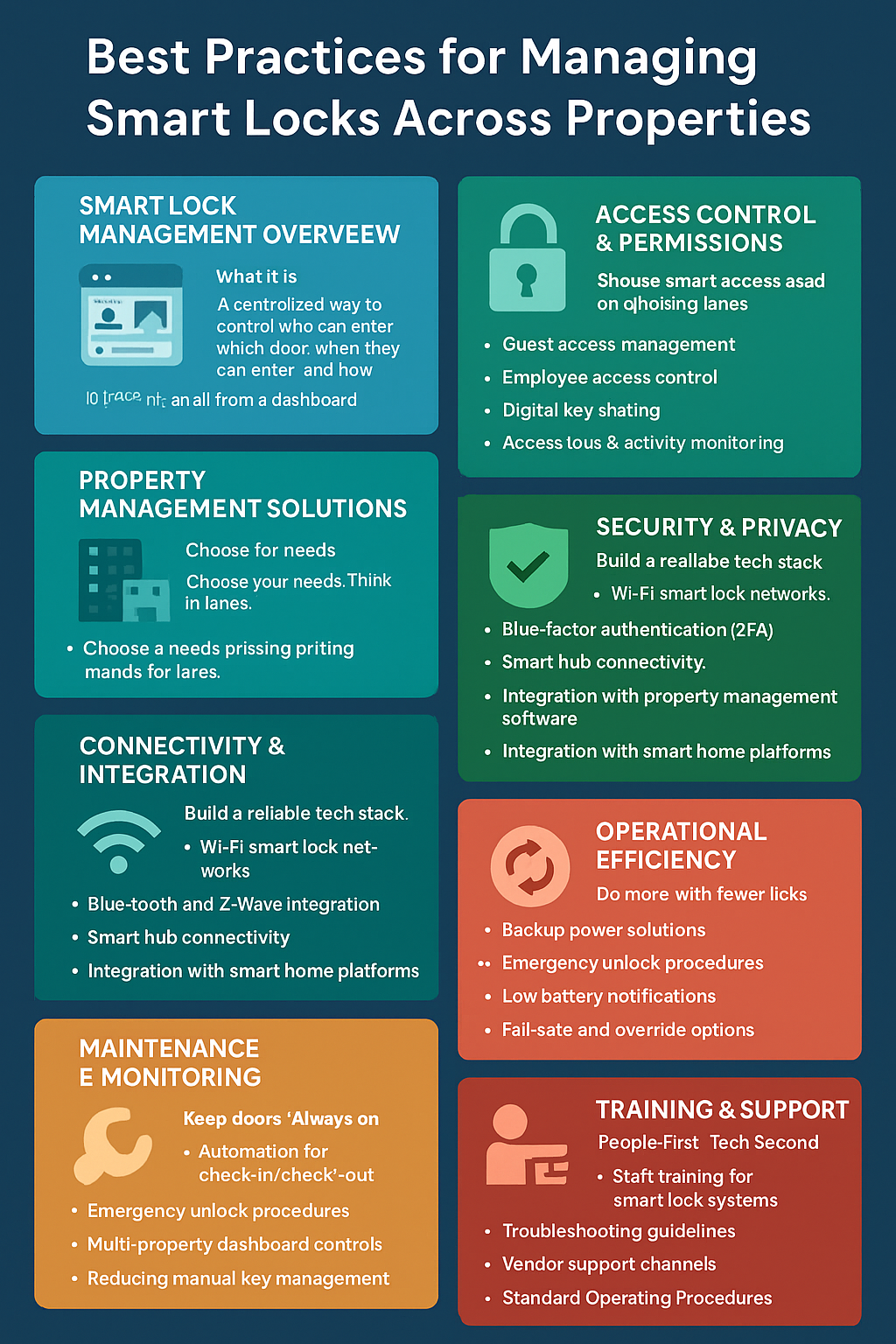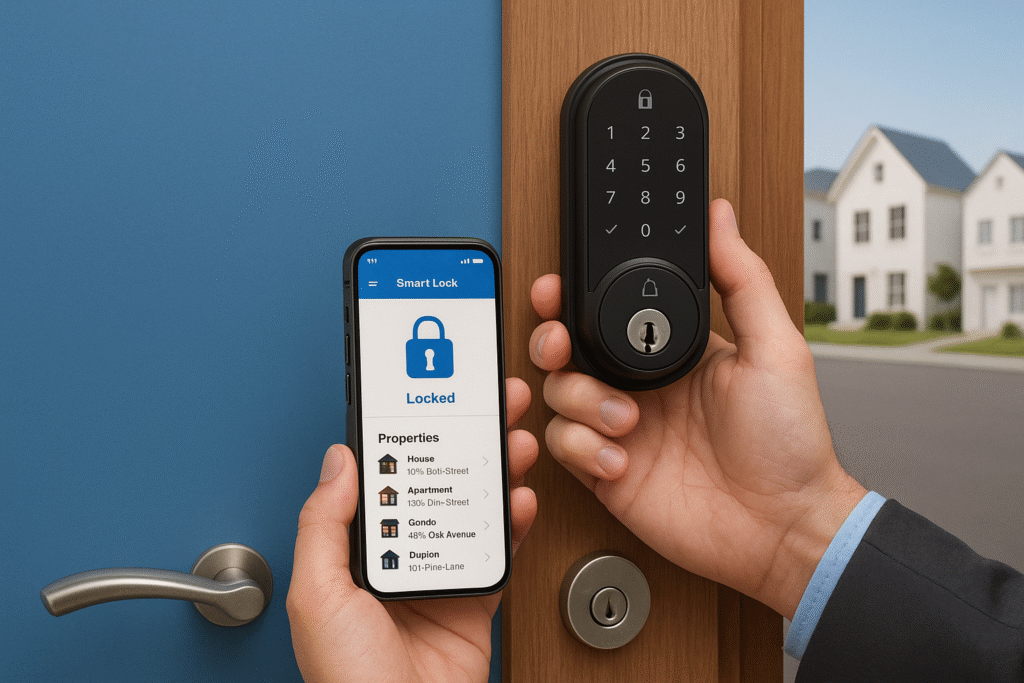Introduction
Imagine juggling 50 sets of keys on a giant metal ring. It’s heavy, noisy, and every time a guest calls at midnight, your heart drops. Now picture the same job with a tidy phone app, a couple of taps, and a quiet “you’re all set.” That’s the magic of smart lock management for multi-property portfolios. Whether you run short-term rentals, a multi-unit building, commercial spaces, or a mix of everything, smart locks can turn daily chaos into calm. This guide walks you through best practices—simple, step-by-step—to run smart locks across properties like a pro.

Smart Lock Management Overview
What it is: A centralized way to control who can enter which door, when they can enter, and how you track it—all from a dashboard.
Why it matters:
- No more lost keys or surprise lockouts
- Clear access logs and activity monitoring for accountability
- Faster check-in/check-out and fewer late-night drives
- Scales with you, from ten doors to a thousand
When you hear terms like multi-property smart lock systems, centralized smart lock management, or remote smart lock administration, they all point to the same goal: managing many doors without being at the door.
Property Management Solutions: Picking Your Lane
Your needs can vary by property type. Think in lanes:
- Smart locks for property managers: You need bulk tools—batch user edits, bulk code creation, and portfolio-level reports.
- Smart locks for multi-unit buildings: Look for shared space control (lobbies, gyms), elevator integrations, and resident self-service.
- Smart locks for rental portfolios: You’ll want scheduling, code rotation, and automation for check-in/check-out.
- Smart locks for short-term rentals: Seamless guest messaging, PMS integration, auto-expiring codes.
- Smart locks for commercial properties: Role-based access for staff and vendors, stricter audit trails, and compliance features.
Choose a platform that speaks your language today and won’t box you in tomorrow.
Access Control & Permissions: Clear Rules, Fewer Headaches
Smart access is about giving the right person, the right access, at the right time.
- Guest access management: Auto-generate temporary access codes tied to reservation dates. Codes should expire like Cinderella’s carriage—right on time.
- Employee access control: Create roles (e.g., Housekeeping, Maintenance, Front Desk). Limit by scheduled access settings so folks only get in during work hours.
- Digital key sharing: Use links or app invites for staff and long-term residents, with a clear paper trail.
- Access logs & activity monitoring: Check who entered and when. Use alerts for unusual patterns (like access in the middle of the night).
Pro tip: Keep permissions simple. If a role needs exceptions all the time, your roles need a rethink.
Security & Privacy: Your Non-Negotiables
Locks are about trust. Bake in security from day one.
- Data encryption standards: Confirm that your platform uses strong encryption in transit and at rest.
- Two-factor authentication (2FA): Turn it on for all admin and staff accounts. No excuses.
- Tamper detection alerts: Doors should tell on themselves—if someone tries to pry, remove, or jam a lock, you get notified.
- Cybersecurity for smart locks: Use strong, unique passwords. Keep admin accounts limited and well-tracked.
- Compliance with privacy regulations: If you collect personal data, ensure your vendor follows regional rules (e.g., GDPR for EU guests).
- Secure cloud storage practices: Backups, disaster recovery plans, and regular security audits are must-haves.
Bottom line: Security is a system, not a switch. Make it an everyday habit.
Connectivity & Integration: Build a Reliable Tech Stack
Every smart lock needs a stable way to talk to your dashboard.
- Wi-Fi smart lock networks: Great for live updates and remote control. Use strong routers, guest networks for tenants, and VLANs for devices where possible.
- Bluetooth and Z-Wave integration: Helpful for battery life and local reliability; often used with a hub for cloud connectivity.
- Smart hub connectivity: A hub can unify Wi-Fi, Bluetooth, and Z-Wave, boosting range and stability.
- Integration with property management software: Connect to your booking or lease system so access is created and removed automatically.
- Integration with smart home platforms: Think Alexa, Google, Apple Home—useful for residents and accessibility.
Rule of thumb: Fewer “bridges” means fewer headaches. Pick devices that play nicely with your existing tools.
Maintenance & Monitoring: Keep Doors “Always On”
Smart locks are like cars—they run better with routine care.
- Remote diagnostics: Check signal strength, battery status, and error codes without visiting the unit.
- Firmware updates: Schedule regular updates during low-traffic hours. Updates patch security and improve features.
- Battery life monitoring: Set alerts when batteries dip below a threshold. Replace before they die, not after.
- Lock health alerts: Get notified if a latch misaligns or a door isn’t fully shut.
- Predictive maintenance practices: Track patterns. If a door eats batteries twice as fast, you might have alignment or temperature issues.
Toolkit to carry: fresh batteries, a power bank (for some models), screwdriver set, graphite or lock-friendly lubricant, and spare strike plates.
Operational Efficiency: Do More With Fewer Clicks
- Automation for check-in/check-out: Codes create and expire automatically. No more manual texting.
- Streamlined keyless entry management: Set recurring schedules for cleaners and rotating vendor codes.
- Multi-property dashboard controls: One place to see battery alerts, overdue firmware updates, and activity across the portfolio.
- Reducing manual key management: Phase out physical keys. Keep a couple of emergency keys in a lockbox for worst-case scenarios.
Time saver: Use templates for roles and schedules. Clone, don’t rebuild.
Power & Reliability: Plan for “What If”
- Backup power solutions: External 9V contacts, USB-C emergency power, or hardwired options in commercial settings.
- Emergency unlock procedures: Keep a documented, step-by-step plan with photos. Store it in both your SOP binder and your team app.
- Low battery notifications: Route alerts to a shared inbox or Slack channel so nothing gets missed.
- Fail-safe and override options: Some doors should fail locked (security) and some fail unlocked (life safety). Match the door to the use case.
Run drills: Twice a year, practice your emergency unlock flow like a fire drill.
Training & Support: People First, Tech Second
- Staff training for smart lock systems: Teach the why, not just the how. Explain access levels, security habits, and guest empathy.
- Troubleshooting guidelines: Give staff quick “if-this-then-that” flowcharts with photos or screen recordings.
- Vendor support channels: Keep a shared note with support numbers, chat links, and account IDs.
- Standard Operating Procedures: Versioned docs for install, onboarding, offboarding, lost phone, and incident response.
Tip: Celebrate wins—like a weekend with zero lockouts. Culture matters.
Evaluation & Optimization: Measure What Matters
- Performance analytics: Track time saved, lockout rate, code generation volume, and average battery life.
- Audit trail analysis: Spot risky access patterns and tighten rules where needed.
- Regular security audits: Quarterly review of users, roles, and admin accounts. Remove “zombie” access.
- Smart lock ROI evaluation: Compare locksmith visits, lost key costs, staff hours, and guest satisfaction before and after rollout.
- Continuous improvement strategies: Pick one improvement per quarter—like faster check-in or better vendor access—and ship it.
Best Brands & Solutions: Matching Needs to Tools
You’ll see several business-friendly options built for portfolios:
- Yale Access Management: Strong ecosystem with reliable hardware and portfolio tools, good for mixed property types.
- August Business Solutions: Friendly apps and auto-unlock features, popular in short-term rentals.
- Schlage Encode Enterprise: Enterprise-leaning controls and sturdy hardware for commercial and multi-unit buildings.
- Nuki Smart Lock Pro Management: Flexible retrofit option, handy where replacing hardware is tough.
- TTLock Cloud Platform: Broad device variety and open ecosystem; useful for global portfolios and budget flexibility.
How to pick: List your must-haves (e.g., PMS integration, Z-Wave, 2FA, audit reports), then map each brand’s strengths to your list. Pilot on 5–10 doors before you scale.
Buying & Implementation Guide
Choosing the Right Smart Lock Management Platform
- Define your property mix (short-term, multi-unit, commercial).
- List integrations you need (PMS, channel managers, smart home).
- Confirm security features (encryption, 2FA, audit logs).
- Align hardware styles (deadbolt vs. lever, retrofit vs. full replacement).
- Check regional support and replacement part availability.
Installation Best Practices
- Test fit on one door first.
- Align strike plates carefully to prevent battery drain.
- Label each lock by building, unit, and door (“B-203-Back”).
- Document Wi-Fi/hub placement and signal tests.
Multi-Property Setup Checklist
- Create org structure: buildings → units → shared spaces.
- Build role templates: Resident, Guest, Cleaner, Maintenance, Manager.
- Set alert routing: batteries, tamper, offline.
- Connect PMS for auto code creation and expirations.
- Schedule firmware windows and create a quarterly audit calendar.
Cost Analysis and Budget Planning
- Hardware per door (lock + bridge/hub if needed)
- Batteries and spares
- Platform subscription per door
- Install labor (in-house vs vendor)
- Training time and documentation
- Contingency fund for replacements
A Mini Case Study: “Sara’s Saturday”
Sara manages 120 mixed units: some short-term rentals, some long-term, and two small office suites. Saturdays used to be a circus. When she switched to a centralized smart lock management platform:
- Codes now auto-create for guests and expire at checkout.
- Cleaners have scheduled access settings from 11 a.m. to 4 p.m.
- A tamper alert once flagged a forced latch; maintenance got a photo, visited, and fixed it before guests arrived.
- Battery alerts show a weekly to-do list. The team replaces low batteries every Wednesday morning—no more midnight oopsies.
- With access logs and activity monitoring, Sara resolved a noise complaint in minutes.
Sara says it feels like going from a paper map to GPS. Same roads, way less stress.

Conclusion: Calm Beats Chaos
Managing smart locks across properties doesn’t have to feel like herding cats. With the right multi-property smart lock systems, clear access control, strong security & privacy, solid connectivity & integration, and a culture of maintenance & monitoring, you can replace key chaos with quiet confidence. Your guests feel safer, your staff moves faster, and your doors do their job without drama.
